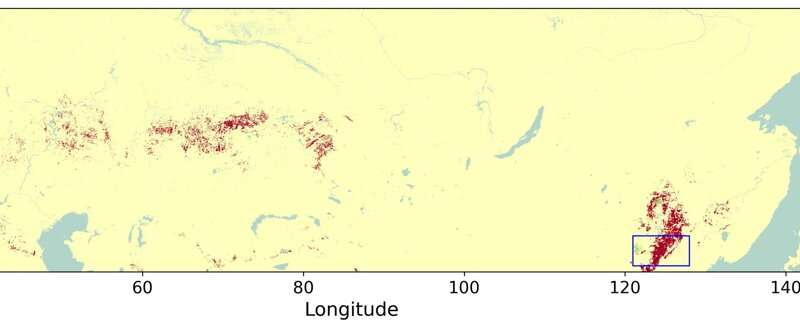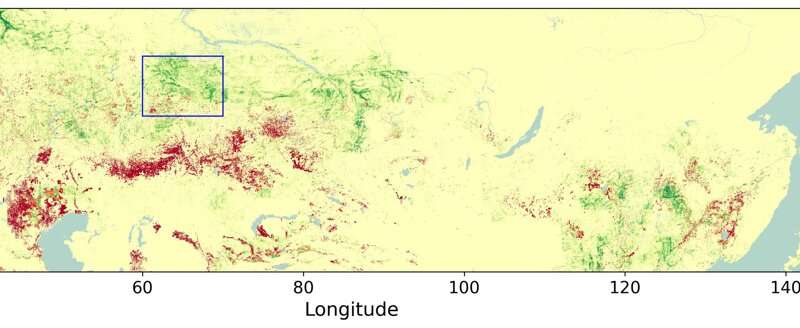This article has been reviewed according to Science X's editorial process and policies. Editors have highlighted the following attributes while ensuring the content's credibility:
fact-checked
peer-reviewed publication
trusted source
proofread
Researchers use AI to predict how agricultural land suitability may change by 2050

By 2050, scientists predict that global demand for food will increase by 110%, while today about 40% of croplands and pastures are under threat due to the increasing average temperature on the planet, high concentrations of greenhouse gases in the atmosphere, and many other factors.
A research team from Skoltech, the Institute of Geography of the Russian Academy of Sciences and other leading research organizations, used a large amount of open data and artificial intelligence to analyze how agricultural land suitability can change in 25 years. They concluded that the number of croplands would increase in the northern territories. The study is published in in IEEE Access.
The research methodology included three stages: collecting and preprocessing data, training a machine learning model, and evaluating results by predicting cropland distribution based on various climate models and shared socioeconomic pathways scenarios. The study focused on the regions of Eastern Europe and Northern Asia.

"The data we use in our work is open, everyone can use it: ERA5 is the data of the climate analysis of the European Weather Forecasting Center, a mix of real measurements from weather stations and models that help to obtain a common grid of 30 x 30 square kilometers around the world. They can be obtained from 1950 to the present day. Other data, CMIP models, are aimed at predicting climate change until 2100. These are climate models that are made in various institutes around the world, including in Russia," said Valery Shevchenko, the first author of the work, a research engineer at Skoltech's Applied AI Center.
Since CMIP models have different accuracy for different climatic parameters (air temperature, wind speed, and others), the researchers obtained three data sets and analyzed them for three different climate change scenarios: a sustainable, low-emission green energy future, a 'business-as-usual' trajectory with moderate emissions, and a high fossil fuel dependency scenario with significantly increased greenhouse gas emissions. To thoroughly study the conditions of irrigation of arable land, the team integrated the global food security-support analysis data at a 1 km x 1 km resolution.
"We have obtained a model that predicts with good accuracy what is now, and used this model to predict what will happen in 2050 using the collected data from CMIP models. We cannot say that this will be 100% the case, because it is important to take into account many parameters here—for example, the type of land, soil erosion. We can only predict trends depending on different scenarios of climate development and attract people's attention to developing strategies for the future today," Valery Shevchenko continued.
-

Heatmap of class probabilities from the ensemble model for major irrigated arable lands classes for 2050 under the 'business-as-usual' trajectory scenario with moderate emissions. Credit: Climate Change Impact on Agricultural Land Suitability: An Interpretable Machine Learning-Based Eurasia Case Study. -

Heatmap of class probabilities from the ensemble model for minor irrigated arable lands classes for 2050 under the 'business-as-usual' trajectory scenario with moderate emissions. Credit: Climate Change Impact on Agricultural Land Suitability: An Interpretable Machine Learning-Based Eurasia Case Study.
The authors conclude that in 25 years the amount of arable land will increase, but it will shift to the north, and some currently exploited agricultural regions may require increased irrigation, posing potential risks.
The authors emphasize that their findings align with and complement recommendations from the Intergovernmental Panel on Climate Change, which highlight the importance of detailed regional assessments for adapting to climate variability and ensuring food supplies.
More information: Valeriy Shevchenko et al, Climate Change Impact on Agricultural Land Suitability: An Interpretable Machine Learning-Based Eurasia Case Study, IEEE Access (2024). DOI: 10.1109/ACCESS.2024.3358865
Journal information: IEEE Access
Provided by Skolkovo Institute of Science and Technology




















